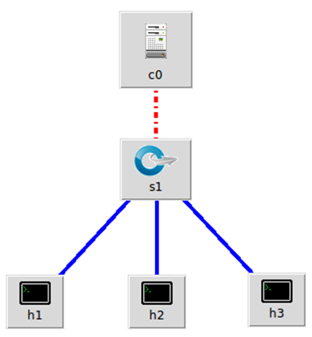实验7:基于REST API的SDN北向应用实践
实验目的
- 能够编写程序调用OpenDaylight REST API实现特定网络功能;
- 能够编写程序调用Ryu REST API实现特定网络功能。
实验要求
(一)基本要求
1.编写Python程序,调用OpenDaylight的北向接口实现以下功能
(1) 利用Mininet平台搭建下图所示网络拓扑,并连接OpenDaylight;

-
搭建拓扑
sudo mn --topo=single,3 --controller=remote,ip=127.0.0.1,port=6633 --switch ovsk,protocols=OpenFlow13 -
连接OpenDaylight:
./distribution-karaf-0.6.4-Carbon/bin/karaf

(2) 下发指令删除s1上的流表数据。
- 创建并编写delete.py文件
touch delete.py
# delete.py
import requests
from requests.auth import HTTPBasicAuth
if __name__ == "__main__":
url = 'http://127.0.0.1:8181/restconf/config/opendaylight-inventory:nodes/node/openflow:1/'
headers = {'Content-Type': 'application/json'}
res = requests.delete(url, headers=headers, auth=HTTPBasicAuth('admin', 'admin'))
print (res.content)
- lab7终端输入
python3 delete.py

(3) 下发硬超时流表,实现拓扑内主机h1和h3网络中断20s。
- 创建并编写 hardtimeout.py 文件
touch hardtimeout.py
# hardtimeout.py
import requests
from requests.auth import HTTPBasicAuth
if __name__ == "__main__":
url = 'http://127.0.0.1:8181/restconf/config/opendaylight-inventory:nodes/node/openflow:1/flow-node-inventory:table/0/flow/1'
with open("./hardtimeout.json") as file:
str = file.read()
headers = {'Content-Type': 'application/json'}
res = requests.put(url, str, headers=headers, auth=HTTPBasicAuth('admin', 'admin'))
print (res.content)
- 创建并编写 hardtimeout.json 文件
touch hardtimeout.json
# hardtimeout.json
{
"flow": [
{
"id": "1",
"match": {
"in-port": "1",
"ethernet-match": {
"ethernet-type": {
"type": "0x0800"
}
},
"ipv4-destination": "10.0.0.3/32"
},
"instructions": {
"instruction": [
{
"order": "0",
"apply-actions": {
"action": [
{
"order": "0",
"drop-action": {}
}
]
}
}
]
},
"flow-name": "flow",
"priority": "65535",
"hard-timeout": "20",
"cookie": "2",
"table_id": "0"
}
]
}
- mininet>
h1 ping h3 - 终端输入
python3 hardtimeout.py

(4) 获取s1上活动的流表数。
- 创建并编写 getflow.py 文件
touch getflow.py
# getflow.py
import requests
from requests.auth import HTTPBasicAuth
if __name__ == "__main__":
url = 'http://127.0.0.1:8181/restconf/operational/opendaylight-inventory:nodes/node/openflow:1/flow-node-inventory:table/0/opendaylight-flow-table-statistics:flow-table-statistics'
headers = {'Content-Type': 'application/json'}
res = requests.get(url,headers=headers, auth=HTTPBasicAuth('admin', 'admin'))
print (res.content)
- 终端输入python3 getflow.py

2. 编写Python程序,调用Ryu的北向接口实现以下功能
(1) 实现上述OpenDaylight实验拓扑上相同的硬超时流表下发。
- 创建并编写 ryu_timeout.py 文件
touch ryu_hardtimeout.py
# ryu_hardtimeout.py
import requests
if __name__ == "__main__":
url = 'http://127.0.0.1:8080/stats/flowentry/add'
with open("./ryu_timeout.json") as file:
str = file.read()
headers = {'Content-Type': 'application/json'}
res = requests.post(url, str, headers=headers)
print (res.content)
创建并编写 ryu_hardtimeout.json 文件
# ryu_hardtimeout.json
{
"dpid": 1,
"cookie": 1,
"cookie_mask": 1,
"table_id": 0,
"hard_timeout": 20,
"priority": 65535,
"flags": 1,
"match":{
"in_port":1
},
"actions":[
]
}
- 重新创建拓扑
sudo mn --topo=single,3 --mac --controller=remote,ip=127.0.0.1,port=6633 --switch ovsk,protocols=OpenFlow13 - mininet>
h1 ping h3 - 终端输入
python3 ryu_hardtimeout.py

(2) 参考Ryu REST API的文档,基于VLAN实验的网络拓扑,编程实现相同的VLAN配置。
- 创建并编写 ryu_topo.py 文件
touch ryu_topo.py
# ryu_topo.py
from mininet.topo import Topo
class MyTopo(Topo):
def __init__(self):
# initilaize topology
Topo.__init__(self)
self.addSwitch("s1")
self.addSwitch("s2")
self.addHost("h1")
self.addHost("h2")
self.addHost("h3")
self.addHost("h4")
self.addLink("s1", "h1")
self.addLink("s1", "h2")
self.addLink("s2", "h3")
self.addLink("s2", "h4")
self.addLink("s1", "s2")
topos = {'mytopo': (lambda: MyTopo())}
- 创建并编写 ryu_vlan.py 文件
touch ryu_vlan.py
# ryu_vlan.py
import json
import requests
if __name__ == "__main__":
url = 'http://127.0.0.1:8080/stats/flowentry/add'
headers = {'Content-Type': 'application/json'}
flow1 = {
"dpid": 1,
"priority": 1,
"match":{
"in_port": 1
},
"actions":[
{
"type": "PUSH_VLAN",
"ethertype": 33024
},
{
"type": "SET_FIELD",
"field": "vlan_vid",
"value": 4096
},
{
"type": "OUTPUT",
"port": 3
}
]
}
flow2 = {
"dpid": 1,
"priority": 1,
"match":{
"in_port": 2
},
"actions":[
{
"type": "PUSH_VLAN",
"ethertype": 33024
},
{
"type": "SET_FIELD",
"field": "vlan_vid",
"value": 4097
},
{
"type": "OUTPUT",
"port": 3
}
]
}
flow3 = {
"dpid": 1,
"priority": 1,
"match":{
"vlan_vid": 0
},
"actions":[
{
"type": "POP_VLAN",
"ethertype": 33024
},
{
"type": "OUTPUT",
"port": 1
}
]
}
flow4 = {
"dpid": 1,
"priority": 1,
"match": {
"vlan_vid": 1
},
"actions": [
{
"type": "POP_VLAN",
"ethertype": 33024
},
{
"type": "OUTPUT",
"port": 2
}
]
}
flow5 = {
"dpid": 2,
"priority": 1,
"match": {
"in_port": 1
},
"actions": [
{
"type": "PUSH_VLAN",
"ethertype": 33024
},
{
"type": "SET_FIELD",
"field": "vlan_vid",
"value": 4096
},
{
"type": "OUTPUT",
"port": 3
}
]
}
flow6 = {
"dpid": 2,
"priority": 1,
"match": {
"in_port": 2
},
"actions": [
{
"type": "PUSH_VLAN",
"ethertype": 33024
},
{
"type": "SET_FIELD",
"field": "vlan_vid",
"value": 4097
},
{
"type": "OUTPUT",
"port": 3
}
]
}
flow7 = {
"dpid": 2,
"priority": 1,
"match": {
"vlan_vid": 0
},
"actions": [
{
"type": "POP_VLAN",
"ethertype": 33024
},
{
"type": "OUTPUT",
"port": 1
}
]
}
flow8 = {
"dpid": 2,
"priority": 1,
"match": {
"vlan_vid": 1
},
"actions": [
{
"type": "POP_VLAN",
"ethertype": 33024
},
{
"type": "OUTPUT",
"port": 2
}
]
}
res1 = requests.post(url, json.dumps(flow1), headers=headers)
res2 = requests.post(url, json.dumps(flow2), headers=headers)
res3 = requests.post(url, json.dumps(flow3), headers=headers)
res4 = requests.post(url, json.dumps(flow4), headers=headers)
res5 = requests.post(url, json.dumps(flow5), headers=headers)
res6 = requests.post(url, json.dumps(flow6), headers=headers)
res7 = requests.post(url, json.dumps(flow7), headers=headers)
res8 = requests.post(url, json.dumps(flow8), headers=headers)
- 启动Ryu控制器
ryu-manager ryu.app.simple_switch_13 ryu.app.ofctl_rest - 重新创建拓扑
sudo sudo mn --custom ryu_topo.py --topo mytopo --mac --controller=remote,ip=127.0.0.1,port=6633 --switch ovsk,protocols=OpenFlow13 - 删除流表
curl -X DELETE http://127.0.0.1:8080/stats/flowentry/clear/1
curl -X DELETE http://127.0.0.1:8080/stats/flowentry/clear/2 - 运行
python3 ryu_vlan.py - mininet>
pingall

(二)进阶要求
OpenDaylight或Ryu任选其一,编程实现查看前序VLAN实验拓扑中所有节点(含交换机、主机)的名称,以及显示每台交换机的所有流表项。
创建并编写 getall.py 文件touch getall.py
# getall.py
import requests
import time
import re
class GetNodes:
def __init__(self, ip):
self.ip = ip
def get_switch_id(self):
url = 'http://' + self.ip + '/stats/switches'
re_switch_id = requests.get(url=url).json()
switch_id_hex = []
for i in re_switch_id:
switch_id_hex.append(hex(i))
return switch_id_hex
def getflow(self):
url = 'http://' + self.ip + '/stats/flow/%d'
switch_list = self.get_switch_id()
ret_flow = []
for switch in switch_list:
new_url = format(url % int(switch, 16))
re_switch_flow = requests.get(url=new_url).json()
ret_flow.append(re_switch_flow)
return ret_flow
def show(self):
flow_list = self.getflow()
for flow in flow_list:
for dpid in flow.keys():
dp_id = dpid
switchnum= '{1}'.format(hex(int(dp_id)), int(dp_id))
print('s'+switchnum,end = " ")
switchnum = int(switchnum)
for list_table in flow.values():
for table in list_table:
string1 = str(table)
if re.search("'dl_vlan': '(.*?)'", string1) is not None:
num = re.search("'dl_vlan': '(.*?)'", string1).group(1);
if num == '0' and switchnum == 1:
print('h1',end = " ")
if num == '1' and switchnum == 1:
print('h2',end = " ")
if num == '0' and switchnum == 2:
print('h3',end = " ")
if num == '1' and switchnum == 2:
print('h4',end = " ")
print("")
flow_list = self.getflow()
for flow in flow_list:
for dpid in flow.keys():
dp_id = dpid
print('switch_name:s{1}'.format(hex(int(dp_id)), int(dp_id)))
for list_table in flow.values():
for table in list_table:
print(table)
s1 = GetNodes("127.0.0.1:8080")
s1.show()
-
运行
python3 getall.py -
mininet>
dpctl dump-flows -O OpenFlow13 s1 -
mininet>
dpctl dump-flows -O OpenFlow13 s2 -
mininet>
dpctl dump-flows

个人总结
本次实验难度不高,实验中由于 python 版本问题出现了一些意料之外的错误,经过排查发现是 python2 和 python3 的不兼容问题,导致有些代码不能正常运行,在改变 python 默认版本为 python3 之后代码正常运行并且得到了正确结果。
在不同模块间切换的时候忘记清理上一次的拓扑信息sudo mn -c之后才能得到正确结果,且在删除流表时要注意对象。
通过本次实验我熟悉了 mininet 、 ryu、 odl 等的使用方法和集合使用,更加深了对这些工具的理解,并且可以通过编写 python 文件进行调用,收获满满。



【推荐】国内首个AI IDE,深度理解中文开发场景,立即下载体验Trae
【推荐】编程新体验,更懂你的AI,立即体验豆包MarsCode编程助手
【推荐】抖音旗下AI助手豆包,你的智能百科全书,全免费不限次数
【推荐】轻量又高性能的 SSH 工具 IShell:AI 加持,快人一步
· 阿里最新开源QwQ-32B,效果媲美deepseek-r1满血版,部署成本又又又降低了!
· Manus重磅发布:全球首款通用AI代理技术深度解析与实战指南
· 开源Multi-agent AI智能体框架aevatar.ai,欢迎大家贡献代码
· 被坑几百块钱后,我竟然真的恢复了删除的微信聊天记录!
· AI技术革命,工作效率10个最佳AI工具
2021-10-26 区间厚度 左右端点标记